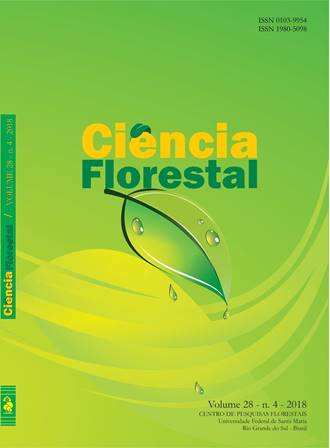ARCHITECTURE AND VERTICAL STRUCTURE OF THE TREE COMMUNITY IN A SUBTROPICAL SEASONAL FOREST
DOI:
https://doi.org/10.5902/1980509835052Keywords:
functional ecology, plant ecology, fitossociology, silvology, functional traitAbstract
This study proposed stipulate the limits and characterize the vertical strata, observing the regularity of the distribution of species abundance, on height gradient of the trees in forest. Data were obtained from fourteen plots (20m x 100m) distributed systematically, registering the species and the total height of the trees with circuference at breast height (CBH) ≥30 cm. The strata were defined from the cluster analysis. We conducted a redundancy analysis (RDA) between species abundance and architectural models, in the vertical strata. For the species distribution in vertical strata was used canonical correspondence analysis (DCA). The community is comprised of four vertical strata. According to the study there was a relationship between the species of the architectural models with the vertical structure of the forest, thus observing that there are strategies of canopy occupation among species according to the architectural model studied. The architectural models with preferential occupancy by certain strata were those of Aubréville for the understorey and the one of Prévost for the emergent strata. Other species presented a wide distribution in the vertical strata of the forest, having no preferential distribution in the vertical structure. Being the models of Massart, Rauh, Roux, Champagnat and Troll, essentials for conformation of the forest arquitecture.
Downloads
References
ANGIOSPERM PHYLOGENY GROUP. Angiosperm Phylogeny Group III. An update of the Angiosperm Phylogeny Group classification for the orders and families of flowering plants: APG IV. Botanical Journal of the Linnean Society, London, v. 181, n. 1, p. 1-20, 2016.
BARTHÉLÉMY, D.; CARAGLIO, Y. Plant architecture: a dynamic, multilevel and comprehensive approach to plant form, structure and ontogeny. Annals of Botany, London, v. 99, n. 3, p. 375-407, 2007.
BORCARD, D.; GILLET, F.; LEGENDRE, F. Numerical ecology with R. New York: Springer, 2011. 306 p.
FINOL, H. Nuevos parâmetros a considerar-se em el análisis estrucutural de las sevas virgenes tropicales. Revista Forestal Venezolana, Merida, v. 14, n. 21, p. 29-42, 1971.
GIEHL, E. L. H. et al. Espectro e distribuição vertical das estratégias de dispersão de diásporo do componente arbóreo em uma floresta estacional no sul do Brasil. Acta Botanica Brasileira, Belo Horizonte, v. 21, n. 1, p. 137-145, 2007.
HALLÉ, F.; OLDEMAN, R. A. A.; TOMLINSON, P. B. Tropical trees and forests: an architectural analysis. Berlin: Springer-Verlag, 1978. 441p.
HELDWEIN, A. B.; BURIOL, G. A.; STRECK, N. A. O clima de Santa Maria, RS. Ciência & Ambiente, Santa Maria, v. 38, p.43-58, 2009.
HOSOKAWA, R. T.; MOURA, J. B.; CUNHA, U. S. Introdução ao manejo e economia florestal. Curitiba: Ed. UFPR, 2008. 164 p.
HUTCHINSON, G.E. Concluding remarks. Cold Spring Harb. Symp. Quant. Biol., 22, 415–427, 1957.
HUECK, K. As Florestas da América do Sul. São Paulo: Polígono, 1972. 466 p.
KLEIN, R. M. Aspectos dinâmicos da vegetação do sul do Brasil. Sellowia, Itajaí, n. 36, p. 5-54, 1984.
KOHYAMA, T. Size-structure tree populations in gap-dynamic Forest-the Forest arquitecture hypotesis for the stable coexistent of species. Journal of Ecology, London, v. 81, n. 1, p. 131-143, 1993.
LAMPRECHT, H. Ensayo sobre la estructura floristica del parte sur-oriental del bosque universitário "El Caimital" Estado Baridas. Revista Forestal Venezolana, Merida, v. 7, n. 10/11, p. 77-119, 1964.
LEGENDRE, P.; GALLAGHER, E. D. Ecologically meaningful transformations for ordination of species data. Oecologia, Heidelberg, v. 129, n. 2, p. 271-280, oct. 2001.
LEITE, P. F.; KLEIN, R. M. Vegetação. In: IBGE. Geografia do Brasil: Região Sul. Rio de Janeiro: IBGE, 1990. p. 113-150.
MORENO, J. A. Clima do Rio Grande do Sul. Porto Alegre, Secretaria da Agricultura, 1961. 42p.
OKSANEN, J. et al. VEGAN: Community Ecology Package. R package version 1.17-8. Viena: [s.n.], 2011. Disponível em: <http://cran.r-project.org/package=vegan>. Acesso em: 21 abr. 2011.
OLDEMAN, R. A. A. Forests: elements of silvology. Berlin: Springer-Verlag, 1990. 624 p.
RAMBO, S. J. B. A fisionomia do Rio Grande do Sul: Ensino de monografia natural. 2 ed. Porto Alegre: Livraria Selbach, 1956. R DEVELOPMENT CORE TEAM. R: A language and envioronmental for statistical computing R. Foundation for Statistical Computing, 2012. Disponível em: < https://www.r-project.org/>.Acesso em: 07 dez. 2012.
SCCOTI, M. S. V. et al. Mecanismos de regeneração natural em remanescente de Floresta Estacional Decidual. Ciência Florestal, Santa Maria, v. 21, n. 3, p. 459-472, 2011.
SOBRAL, M. et al. Flora Arbórea e Arborescente do Rio Grande do Sul, Brasil. 2.ed. São Carlos:
RiMa, 2013. 362 p.
STRECK, E. V. et al. Solos do Rio Grande do Sul. 2. ed. Porto Alegre: EMATER/RS; ASCAR, 2008. 222 p.
THE INTERNATIONAL PLANT NAMES INDEX (IPNI, 2012). Disponível em:<http://www.ipni.org>. Acesso em: 26 ago. 2012.
TOMLINSON P. B. Branching and axis differentiation in tropical trees. Tropical trees as living systems, 1932, Edited by P. B. Tomlinson and Martin H. Zimmermann, 2010. Cambridge University Press, London – New York – Melbourne. p.187 – 207, 2010.
VEGA, C. L. Observaciones ecologicas sobre los bosques de roble de la Sierra Boyacá, Colombia. Turrialba, Turrialba, v. 16, n. 3, p. 286-296, 1966.
VESTER, H. F. M. The trees and the forest. The role of tree architecture in canopy development; a case study in secondary forests (Araracuara, Colombia). 1997. 180 f. Tesis (Doctoral) - Universiteit van Amsterdam, Amsterdam, 1997.
VESTER, H. F. M.; SALDARRIAGA, J. Algunas características estructurales, arquitectónicas y florísticas de la sucesión secundaria sobre Terrazas Bajas en la región de Araracuara (Colombia). Revista de La Facultad Nacional de Agronomía, Medellín, v. 1, n. 2, p. 15-45, 1993.







